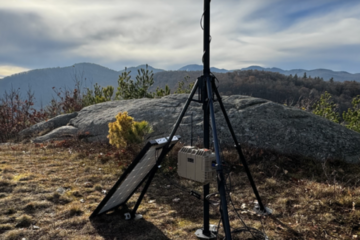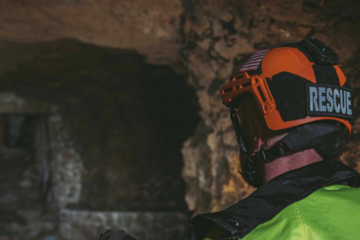The role of mobile mesh in countering the UAS threat

In our last article on The Last Mile, we featured an interview with Matthew Semovoski, a Post Sales Support Engineer for D-Fend Solutions, in which Matthew explained the challenges the Department of Defense (DoD) and law enforcement organizations face when countering the threat of malicious unmanned aerial systems (UAS).
Ultimately, UASs – or drones, as they’re more commonly known – have increased in usage and become pervasive in our society. As a result, the potential for them to create public safety or national security problems has also increased – whether on purpose or as a result of user negligence or carelessness.
During the first part of our conversation with Matthew, we explored the UAS threat and the technologies that exist to help law enforcement and military organizations counter UASs. In the second half of our discussion, we asked Matthew about some recent announcements from D-Fend, including news about some new partnerships. We also asked about how mobile mesh networking can enable the use of counter UAS measures in off-grid environments.

The Last Mile (TLM): How often are your customers operating off-grid? What challenges does that create?
Matthew Semovoski: Quite often. This scenario is most common with our military, defense, and federal law enforcement customers. This use can be due to the lack of connectivity resources in remote or austere operating locations or operational security concerns.
Although real-time data can be easily obtained locally at the system without the ability to share information over a network, decision-makers who may be located away from the system may not be able to respond appropriately to critical threats in a timely manner.
In addition, if there are multiple systems deployed without a network solution, an operator will be required at each system to view the data in real-time.
“D-Fend’s partnership with Syzygy offers a multilayered counter-UAS system that expands safety and security in a range of scenarios and environments.” – Matthew Semovoski
TLM: Some of the same events and situations where D-Fend is utilized – event security, etc. – also face situational awareness and communications challenges. How can mobile mesh networks be deployed in these scenarios?
Matthew Semovoski: Wave Relay systems are most often used for mesh network deployment where traditional networks may not be available. This type of network uses peer-to-peer connections to allow data to travel wirelessly through multiple nodes until it reaches its endpoint.
The benefit is quick deployment and the ability to place systems in locations where a traditional wired ethernet connection may not exist or be easily accessible. Although wave relay is the most common deployment, our system can easily integrate into any secure customer-provided IP-based network that meets minimum latency requirements.
Our network integration and data-sharing capabilities are even further increased through our partnerships with Syzygy and goTenna.
TLM: How can mobile mesh networking solutions and D-Fend be utilized together to increase the security, situational awareness, and communications of large public events and other high-security situations?
Matthew Semovoski: Mobile mesh networking solutions allow us to bring all the data to a central location. Providing real-time data and information to all stakeholders is critically important. This ability enables the decision-makers to capture all the necessary information to understand the data, plan, and act promptly.
Having data delivered from multiple sensors via the mesh network also allows us to utilize our Multi-Sensor Command and Control (MSC2) to merge all the data into a single Common Operating Picture (COP) through sensor fusion. Without network solutions, operators must rely on offline communication methods to share information from multiple data sources, leading to delays, mistakes, and slower response times.
“Integrating EnforceAir with SNAP will optimize cross-functional tactical data flow and communications for various C-UAS scenarios, sectors, and use cases, delivering more robust airspace safety and security.” – Matthew Semovoski
TLM: D-Fend recently announced it was integrating its EnforceAir C-UAS solution with Syzygy’s Sensor Network Access Point (SNAP) solution. What will integrating these solutions accomplish? What new capabilities will it enable for defense and law enforcement organizations looking to counter rogue drones?
Matthew Semovoski: The integration of EnforceAir and Syzygy’s SNAP will strengthen support for the Team Awareness Kit/Tactical Assault Kit (TAK) across government, military, and first responder agencies in contending with rogue drone activity at sensitive and critical sites and events.
TAK is a cost-effective, off-the-shelf government-sponsored solution developed by the Department of Defense that enables tactical data generation, visualization, and sharing to facilitate communications across multiple users and achieve shared tactical situational awareness.
This integration also enables EnforceAir to immediately work with camera systems, radars, and other sensor technologies for fusion and filtering via all the capabilities in SNAP. SNAP also simultaneously enables all the sensor data to work across enterprise networks via secure connections, mobile ad-hoc networking (MANET), goTenna, and Iridium.
With the development of Syzygy’s EnforceAir ATAK SNAP plugin, EnforceAir can be easily integrated into the existing ATAK network quickly with minimal effort.
TLM: Why did D-Fend choose to partner with Syzygy for this integration? What about their company and solution made them the right choice for D-Fend?
Matthew Semovoski: Syzygy’s SNAP offering, and its presence in the defense sector, positions it as an ideal partner in our support for layered defense-based partnerships. Integrating EnforceAir with SNAP will optimize cross-functional tactical data flow and communications for various C-UAS scenarios, sectors, and use cases, delivering more robust airspace safety and security.
D-Fend’s partnership with Syzygy offers a multilayered counter-UAS system that expands safety and security in a range of scenarios and environments.
“The integration of EnforceAir and Syzygy’s SNAP will strengthen support for the Team Awareness Kit/Tactical Assault Kit (TAK) across government, military, and first responder agencies in contending with rogue drone activity at sensitive and critical sites and events.” – Matthew Semovoski
TLM: Mobile mesh networking solution provider goTenna, was also mentioned in the announcement about this integration. How can their solution play a role in countering the UAS threat?
Matthew Semovoski: goTenna brings enterprise situational awareness to the extreme tactical edge for C-UAS focused security agencies through its mobile mesh network solution.
goTenna’s mesh networks capability to enable off-grid connectivity anywhere, and augment traditional communications networks, particularly in areas where it was impossible to access connectivity, is a valuable addition to the comprehensive combined set of C-UAS solutions.








No Comment